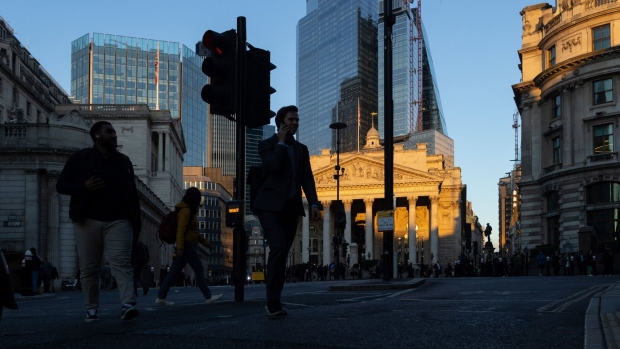Sep 30, 2022
Pound Drops After Reports UK Won’t Speed Up Watchdog Forecast
, Bloomberg News

(Bloomberg) -- The pound is poised to end the week as the world’s most volatile major currency, whipsawed by the UK government’s radical fiscal plans and the Bank of England’s effort to stave off market panic.
The turbulence has pushed a gauge of its historical volatility this week to 22%, the most among major currencies tracked by Bloomberg, eclipsing the level on notoriously skittish peers such as the Norwegian krone and Brazilian real.
Traders remain on edge as they grapple with the violent price swings. The currency rallied from a record low of less than $1.04 on Monday to over $1.12 early on Friday, buoyed in part by the BOE’s pledge to stave off a collapse in the UK bond market. The pound then erased Friday’s gains and was hovering around $1.11 as of 12:30 p.m. in New York.
The fundamental backdrop for the currency remains gloomy, as more expansive fiscal stimulus risks fanning inflation and weakening public finances. But sentiment is already so bearish and positioning stretched, investors are loath to rule out the risk of another pop higher.
“It’s been some rollercoaster ride for the pound this week,” said Viraj Patel, strategist at Vanda Research. “The pound will be a battle between short squeezes and speculators wanting to chase a move toward parity.”
For now, it looks like the government will remain unwavering on its fiscal plan, which includes the largest package of tax cuts in half a century. Despite calls for the government to release the fiscal watchdog’s forecasts early to help quell market nerves, the Treasury said there was no plan to accelerate its publication earlier Friday.
Truss Won’t Change Fiscal Plan After UK Watchdog Meeting (1)
“Sterling remains vulnerable,” said Gareth Gettinby, an investment manager at Aegon Asset Management. “However, many investors have already sold sterling and positioning is very extreme. As such I think volatility will remain elevated with a lot of choppy action.’
©2022 Bloomberg L.P.






